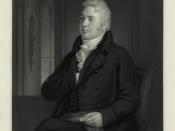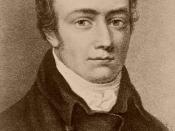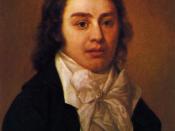Samuel Taylor Coleridge was one of the most well-known poets from a period known as romanticism; a movement that originated in the late 18th century and stressed strong emotion and imagination. A deepened appreciation of the beauties of nature; a general exaltation of emotion over reason and of the senses over intellect; a turning in upon the self; a new view of the artist as a supremely individual creator, whose creative spirit is more important than strict obedience to formal rules and traditional procedures, and an emphasis upon imagination as a gateway to inspirational experience and spiritual truth were just some of the characteristic attitudes existing at this time. Obviously, the ideas and the writing style of Coleridge were affected by the period in which he was writing. He claimed that the definition of poetry and fine arts "are to express intellectual purposes, thoughts, conceptions, sentiments, that have their origin in the human mind..."
(Abrams 1971, 48).
Many of these thoughts and conceptions were conceived in times of quiet reflection and contemplation. The themes of sound and silence are therefore important, as shown in Coleridge's conversation poems. There are nine conversation poems, which are considered by many to be amongst his finest work. These are internalised conversations which Coleridge has recorded, and largely concern his friends, family members or children. They were written between 1794-1798, while Coleridge was living in the West Country.
'The Aeolian Harp' was a poem of courtship, written at the cottage in Cleveden in the summer before his marriage to Sara Fricker. Throughout Coleridge considers his joy in the scents of the evening and the quietness of the place. The silence is only broken by the "simplest lute", which plays music as the wind blows across it. The "delicious surges sink and rise", conjuring up images...



This paper is heaven sent!!
Thank You! This paper is what i was looking for. It totally help me with my finals. Aside from the fact that i spotted the question of sound and silence. Anyways..You Rock!!!
1 out of 6 people found this comment useful.